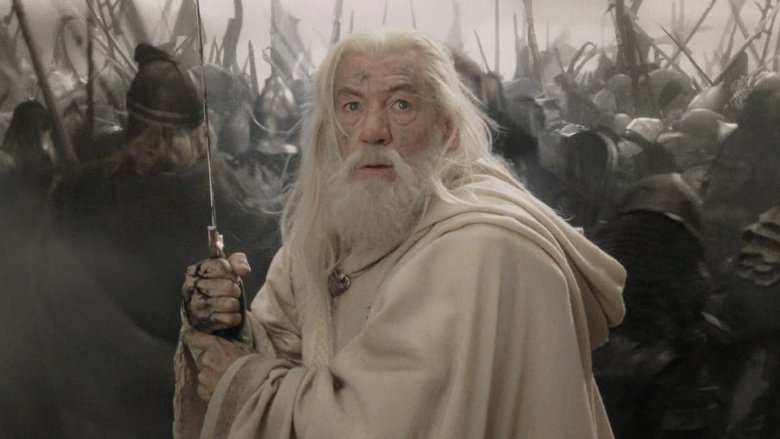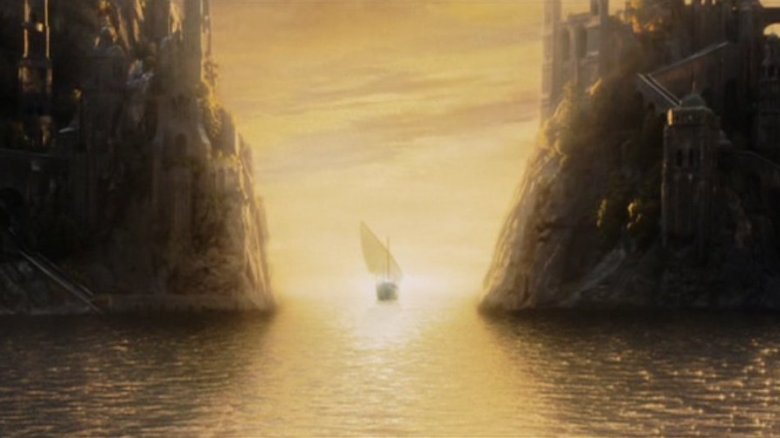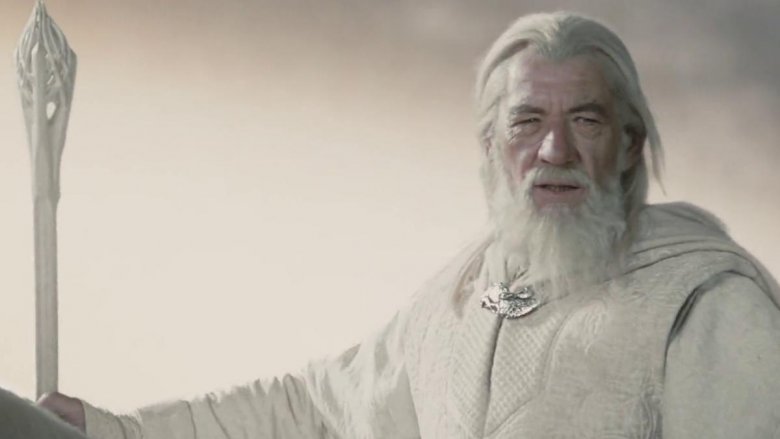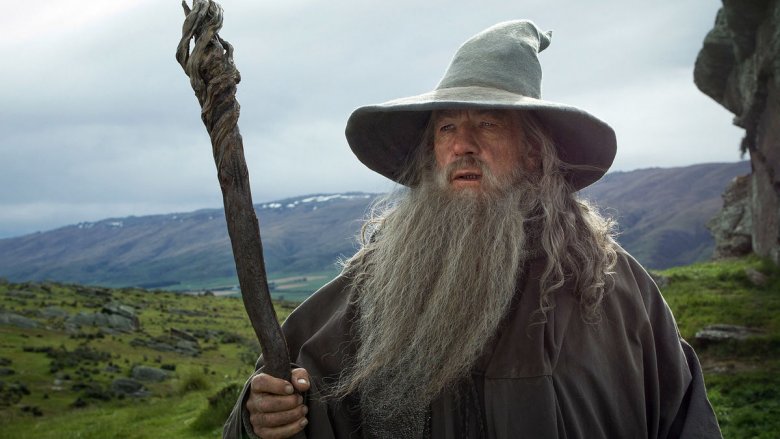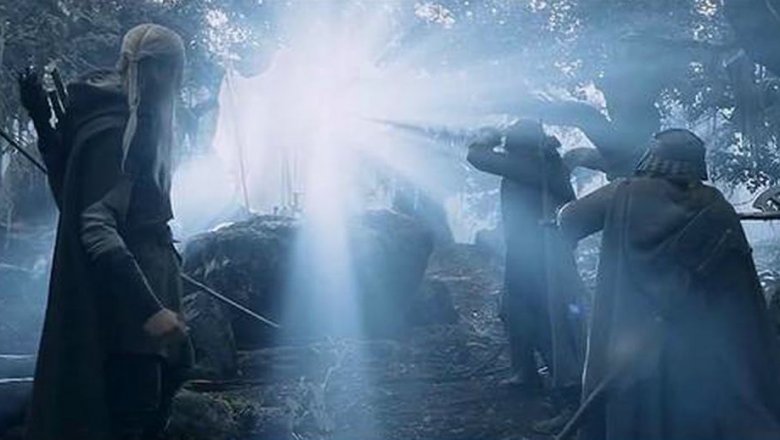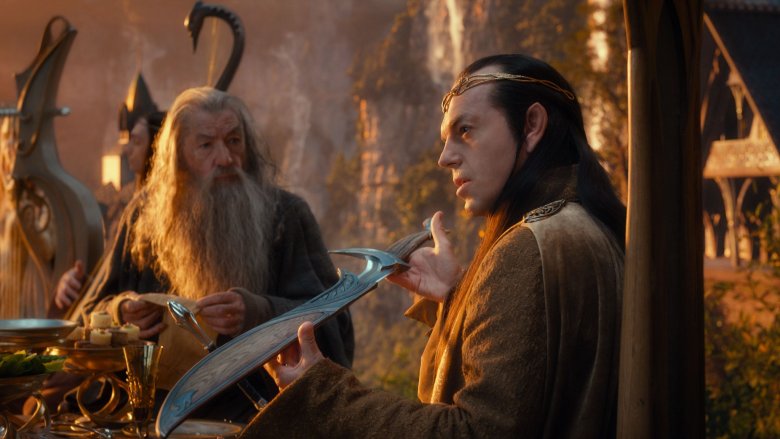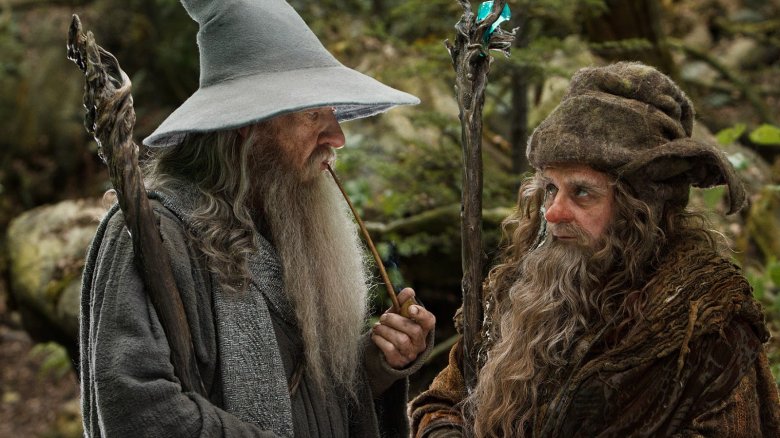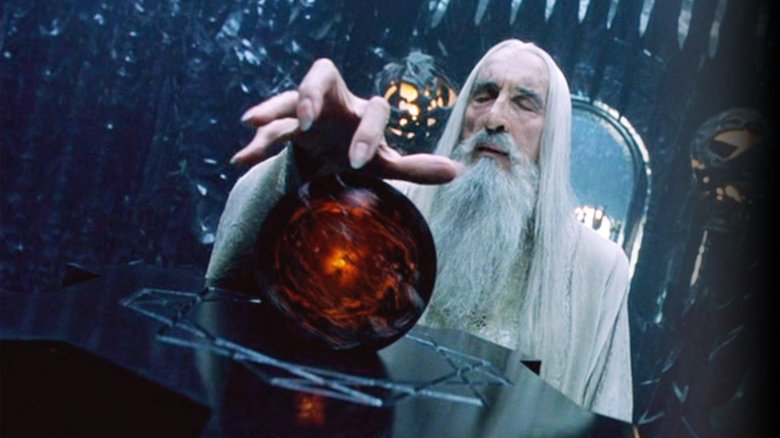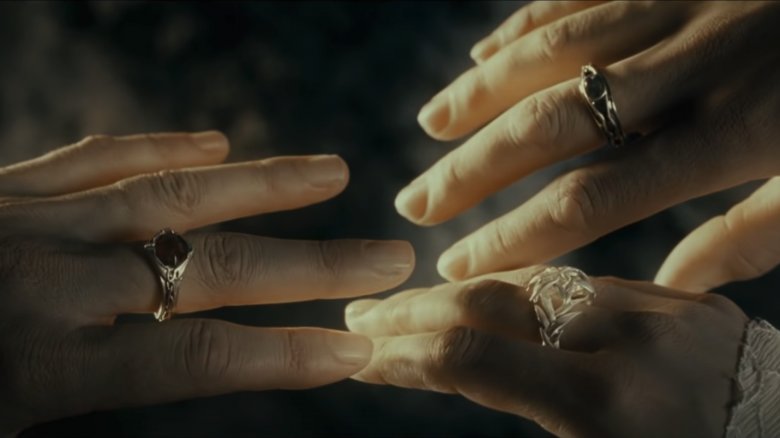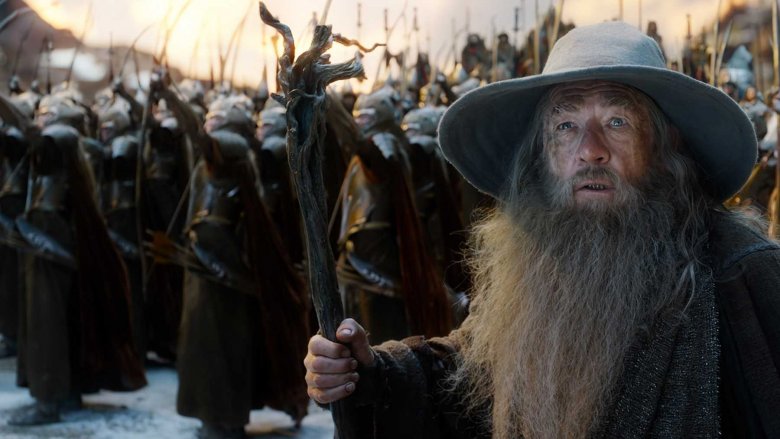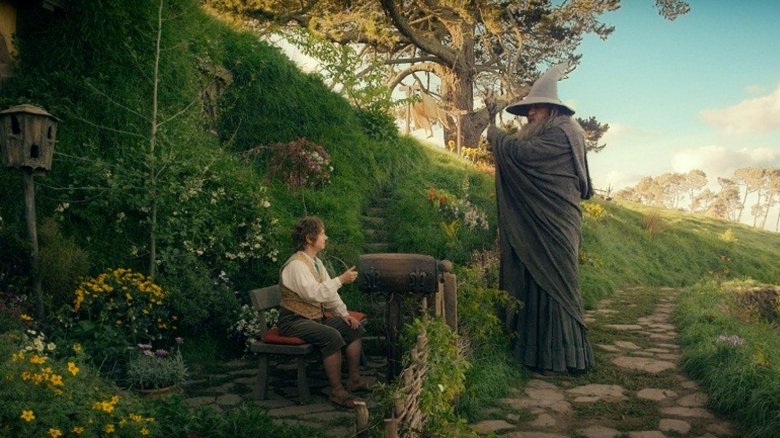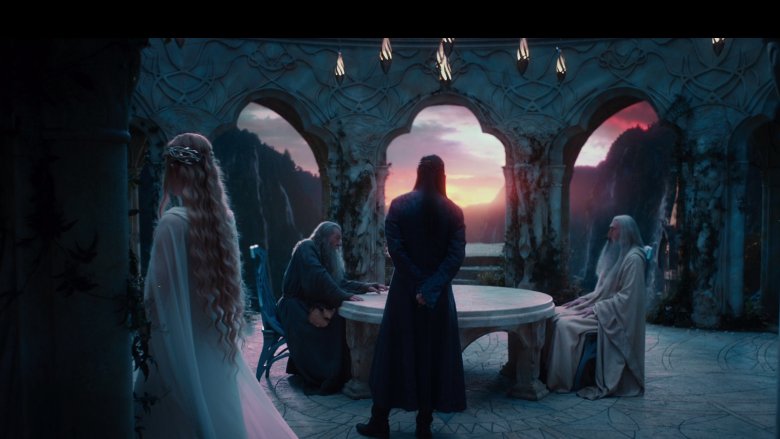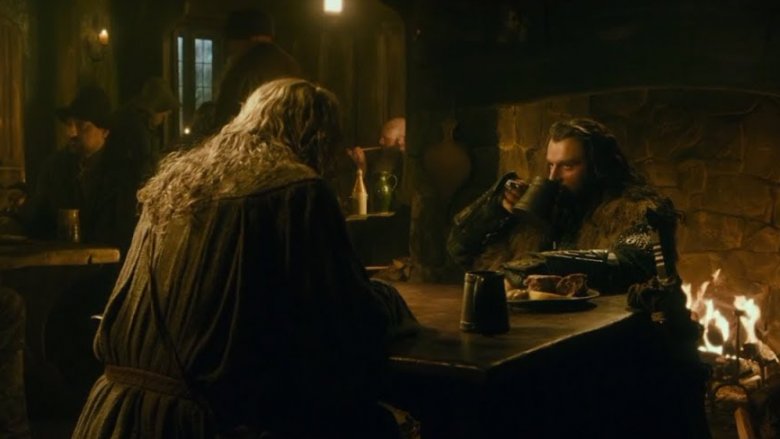Gandalf's Backstory Explained
J.R.R. Tolkien's epic The Lord of the Rings juggles a lot of different characters. Hobbits, Dwarves, Elves, and Men all figure prominently on the printed page, the silver screen, and soon even our personal television sets. But there's one character in the story that stands out (especially when you take his tall, pointed hat into consideration). We're talking, of course, about Gandalf. The wizard is unique, not only because of the instrumental part he plays throughout the story but also because, well, he's a wizard.
Wizards in Tolkien's world aren't trained at Hogwarts. Nor do they consist of various people from different races simply "practicing magic." The concept of a wizard from Middle-earth is about as unique in the fantasy world as Gandalf himself is in The Lord of the Rings.
So what, exactly, are Tolkien's wizards, then? And what does that make Gandalf? What is the background of this strange wanderer, dressed all in grey? Where did he come from and why is he meddling in everyone's affairs in the first place? Let's dive into the Grey Pilgrim's backstory and see what it is that sets Gandalf up for the critical role that he ends up playing throughout The Hobbit and The Lord of the Rings.
Beginnings in the West
Gandalf first comes into existence at the beginning of time itself. He is initially a supernatural entity, created by Tolkien's supreme being, Ilúvatar. After the creation of Arda (that is, the world as a whole), he comes to live within it along with a host of other celestial beings like himself, called Ainur, thousands upon thousands of years before The Lord of the Rings takes place.
During this period of "youth," he is named Olórin, and he lives in the lands to the west of Middle-earth. He spends a good deal of his time in Lorien, a heavenly land filled with gardens, lakes, and rivers. He also keeps company with Nienna, a Valar or leader of the Ainur who is known for her association with grief and sorrow. This helps him learn much about patience and pity.
Throughout his existence, Gandalf is always drawn to the "Children of Ilúvatar" — that is, both Elves and Men — and is always keen to help them. However, he typically doesn't reveal himself to them in his true form, rather choosing to communicate to them through visions — hence his name Olórin, part of which Tolkien translated at different times as "fantasy" or "dream."
A Maiar
The supernatural Ainur are the highest order of beings within Middle-earth, and they are broken into two different groups. The Valar, made up of 14 Ainur including Nienna, are the kings and queens that rule over creation in the name of Ilúvatar.
Every other Ainur is part of the group called the Maiar. In the book Unfinished Tales — which compiled many of Tolkien's unpublished and unfinished works — the author refers to these creatures as an "angelic" order of beings. It's not known how many Maiar there were, but several of them show up throughout Middle-earth history and are very powerful. Sauron, for instance, is probably the most well-known Maiar. The Balrog that lives in Moria is another, less powerful, of the creatures.
However, while those two are forces for evil, there were many, many other Maiar that fought for good — including Gandalf. While he isn't as impressive on the surface, the Grey Wanderer's great claim to fame is the fact that in The Silmarillion he's referred to as "the wisest of the Maiar." It's an impressive attribute, considering the fact that every single one of them are eternal, deeply spiritual beings.
The Order of the Wizards
Along with being one of the wisest of the Maiar, Gandalf, as everyone knows, is also a wizard. But as we hinted at before, the idea of a "wizard" is a bit of a misnomer when compared to the modern English definition of the word. In Unfinished Tales, Tolkien explains just what Middle-earth wizards are and why they're so different from their modern counterparts.
He explains that "wizard" is a translation of the Elvish word "istar," representing an order that claims to have "eminent knowledge of the history and nature of the World." These wizards, or "Istari," are distinct from the sorcerers and magic peddlers typically associated with the name. In reality, they're a specific subset of Maiar that operated in the Third Age of Middle-earth history.
There are five main wizards in Tolkien's writings, literally referred to in The Two Towers as the "Five Wizards," but the Unfinished Tales also explains that their total number is actually unknown and some very well may have visited different areas besides the northwestern portion of Middle-earth.
How Tolkien's wizards work
On the inside, so to speak, the Istari are technically angelic, supernatural beings from the glorious west. However, the important distinction that makes a Maiar a wizard is the fact that they've voluntarily been wrapped in the frail mortality of a worldly body. And this isn't just putting on an appearance so that they can blend in with Men and Elves, either. Their bodies are the real deal.
It's made clear in Unknown Tales that the physical forms that the wizards take restrict their abilities and even have the effect of "dimming their wisdom and knowledge and confusing them with fears, cares, and wearinesses coming from the flesh."
This restriction is a natural side effect of the nature of their existence in the first place. The wizards were created and sent to Middle-earth specifically to help resist Sauron. Because of this, it says in The Silmarillion that they were forbidden to simply overpower the Dark Lord with their own latent power, nor were they allowed to dominate Men or Elves in order to do so. In other words, wizards are Maiar wrapped in physical, restricting bodies that were sent to Middle-earth in order to help (not dominate) the peoples resist the growing power of Sauron.
Messengers to Middle-earth
While he's been around from the beginning of Time, it turns out that it isn't until well into the Third Age that Gandalf is asked to take on his wizard form.
According to one note in Unfinished Tales, the head of the Valar, Manwë, personally chooses Gandalf to become the "director and coordinator of attack and defense." However, Gandalf's initial reaction is to resist the nomination, as he is afraid of Sauron's power. But Manwë insists, explaining that his wise fear is precisely why he is particularly suited to the task.
Eventually, the five main wizards are chosen and they begin to arrive on the western coast of Middle-earth approximately one millennium into the Third Age. This roughly coincides with the first whisperings of Sauron beginning to set himself up in Mirkwood as the Necromancer that we eventually meet in The Hobbit trilogy. According to one version of the story, Gandalf comes last of all the Istari, and it's said that he's very unimposing. He's shorter than the others, already has grey hair, and leans on a staff. In fact, the specific word used to explain his appearance is that he comes across as the "least" of the intrepid mortality-clad Maiar.
The Five Wizards
Of the Five Wizards, Gandalf is clearly the most well known. Two others appear at times throughout The Hobbit and The Lord of the Rings stories and the last two have no active part in the narrative and are barely discussed. Each of these five representatives of the Valar have different strengths and, while they knew each other, they clearly weren't supposed to work together as a team at all times.
Up front, the most impressive of the Five Wizards is Saruman. Also called Curunír or "the Man of Skill," he was the first to arrive in Middle-earth. He proudly came dressed in white, which contrasted boldly with his hair, which was raven black at the time. Next up, we have Radagast. Clad in earthen brown, Radagast was very interested in beasts and birds. One version of the story in Unfinished Tales also explains that Radagast was paired up with Saruman as a favor to the Valar, Yavanna, much to Saruman's dismay and disdain.
Last, and certainly least as far as the story goes, were the Blue Wizards. This pair of Maiar, dressed in sea-blue clothing, were named Alatar and Pallando and it's said that they traveled to Middle-earth as friends.
The Unfaithful
While the idea of having five Gandalf equivalents wandering around Middle-earth sounds like a great way to fight back against Sauron, it turns out that the only member of the team that genuinely had a net positive effect ended up being Gandalf. Tolkien refers to him as the only one that remains "faithful" to his mission of providing aid to the free folk who were resisting Sauron.
Saruman's failure is well documented. The Wizard becomes corrupt with power and goes against the Istari's commission by dominating the wills of others and setting himself up as a contender against Sauron. Radagast's fate is quietly tragic, as the wizard slowly slips into a habit of overly prioritizing the birds and beasts rather than Elves and Men. His fate isn't clearly recorded, but it seems to be one of irrelevance at the least.
The Blue Wizards have long remained a fascination to Tolkien fans if only because of their utter and complete mystery. Tolkien himself would talk about them as if they were a riddle that he didn't have time to solve. It's said that the duo traveled far into the east with Saruman but never came back. In fact, in a letter in 1958, Tolkien explained that he didn't know what happened to them, but he feared that they failed in their mission and may have even founded secret cults of magic before all was said and done.
Wielding a ring
One final note about Gandalf's first appearance in Middle-earth has to do with a gift he's given when he arrives. When he first meets the shipwright Círdan at the Grey Havens (that's the port where Frodo leaves at the end of The Return of the King) the Elven lord immediately sees right through the wizard's lowly appearance and recognizes the important role that Gandalf is going to play in the war against Sauron.
This leads Círdan to give Gandalf a ring of power to help him throughout his adventures. No, not the One Ring of power, but a heavy-hitting piece of enchanted jewelry nonetheless. Círdan's gift is Narya the Red, one of the three Elven rings. The potent ring is meant to help support Gandalf through his labors and aid him in sparking courage in the hearts of those that he helps. While Gandalf accepts the gift, he attempts to keep it very secret. However, he's unable to conceal it from Saruman, who becomes jealous over the preferential treatment. In fact, according to Tolkien, this is the first thing that starts to erode the friendship between the two wizards.
Lonely wanderings
When the Five Wizards arrive in Middle-earth, the events of The Hobbit and The Lord of the Rings are still roughly 2,000 years in the future. So one big question that has to be asked is what Gandalf does to kill the time. His name rarely appears during the major geopolitical events of the age, and he seems to have practically fallen off the map for huge swaths of time.
Fortunately, Tolkien gives us a little hint of the answer in Unfinished Tales when he says, "Probably he wandered long (in various guises), engaged not in deeds and events but in exploring the hearts of Elves and Men who had been and might still be expected to be opposed to Sauron."
In other words, he spends a lot of time wandering all over the Westlands of Middle-earth, generally laying low, making friends, and increasing his understanding of the lay of the land. He doesn't settle down at all during this point, either — remember, he's known as the "Grey Wanderer" or the "Grey Pilgrim." This contrasts starkly with his fellow Istari teammates, as Radagast eventually settles down at his home of Rhosgobel on the edge of Mirkwood and Saruman famously sets up shop at Isengard.
Many names
With so many centuries of wandering under his belt, it's natural that Gandalf would acquire a lengthy collection of names. Tolkien, yet again, obliges us through multiple sources, especially Unfinished Tales, by providing several of them, often along with their origins and meanings. The name Gandalf means "the Elf of the Wand," since Men thought he was an Elf. Tolkien himself admitted that he got that one directly out of Norse mythology.
Beyond that, though, the Wandering Wizard also reveals in The Two Towers that "many are my names in many countries." We've already heard of Olórin, his name in the West at the beginning of Time. The Elves also call him Mithrandir, which means "the Grey Pilgrim." Adding to the list of monikers, the Dwarves call him Tharkûn, which translates to "Staff-man."
He also says that in the South he's called Incánus. However, Tolkien himself seemed to be unsure about how to explain this last one. In one note, he says that it comes from the Haradrim language and meant "alien" or "North-spy." However, in later notes, he claimed it was just a common name for the Grey Pilgrim in Gondor, which was relatively "south" compared to his general stomping grounds. Whichever way you slice it, though, there's no doubt that the wizard develops a pretty impressive collection of names over the course of his nomadic career.
Helping Hobbits
One other critical activity that Gandalf participates in during the centuries before The Lord of the Rings is befriending Hobbits. Amongst all the wise, Gandalf is the only one that sees the value of the Halflings, making a distinct effort to cultivate a deep connection with the agricultural community of the Shire. He helps them when they're in need and is specifically remembered in the appendix of The Return of the King for aiding them during the desperate Long Winter of 2758.
He also entertains the Shire-folk whenever possible, establishing a reputation for his incredible fireworks, magic tricks, and excellent storytelling. On the flip side, he also gets a bit of a bad rap throughout their tranquil community for convincing many quiet Hobbit "lads and lasses" to run "off into the Blue for mad adventures." At least, that's how Bilbo puts it when he bumps into the wizard while blowing smoke rings by his front door. Needless to say, when the great events of The Hobbit and The Lord of the Rings roll around, Gandalf is firmly established as a local legend within the Hobbit communities.
The White Council and other Adventures
While Gandalf appears to lay low for most of his time in Middle-earth, that doesn't mean he does nothing at all. A thousand years after his arrival, he visits the fortress of Dol Guldur in southern Mirkwood where Sauron has been rebuilding his power in the form of the Necromancer. The wizard drives the Dark Lord out (although he doesn't realize who he is yet), leading to the centuries-long period of the Watchful Peace.
He also serves as a member of the Council of the Wise, also known as the White Council, which is composed of Saruman, Galadriel, Elrond, and Círdan, among others. Gandalf is actually considered to lead the prestigious body at one point, but he doesn't want to be restrained from wandering and the position is awarded to his fellow wizard Saruman instead.
At one point, a bit later on, Gandalf also sets out in search of the missing Dwarven king Thráin II. In his search, he journeys through Moria and then revisits Dol Guldur. Here, he finds the Dwarf — who gives him a map and a key for the Lonely Mountain — in prison and finally discovers that the Necromancer has returned and is, indeed, Sauron. He tells the White Council and urges them to attack while their enemy is unprepared. The Council eventually attacks and defeats Sauron, at which point he withdraws to Mordor.
A chance meeting
As some may have already noticed, we've started to spill into the events of The Hobbit at this point, and the "backstory" of Gandalf is drawing to a close. Perhaps the best spot to tie things in with the mainstream story is with a chance meeting near the Prancing Pony. Once again turning to Unfinished Tales, we find Gandalf riding along one day on his way to the Shire for a sabbatical. As he nears the inn of the Prancing Pony in Bree, he's busily pondering on the impending evil threats scattered throughout Middle-earth.
Suddenly, who should he run into but Thorin Oakenshield himself. The Dwarven hero is also deep in thought as he travels in exile thanks to Smaug the dragon, who has taken up residence in his mountain home half a world away. The two begin to talk, and Gandalf decides to visit the dwarf's temporary home.
After further discussion, the wizard heads to the Shire as he mulls the situation over. Not long afterward he hears about the eccentric Hobbit bachelor Bilbo Baggins, whom he hasn't seen since Baggins was a child. He starts making a plan, and the rest is Middle-earth history.
